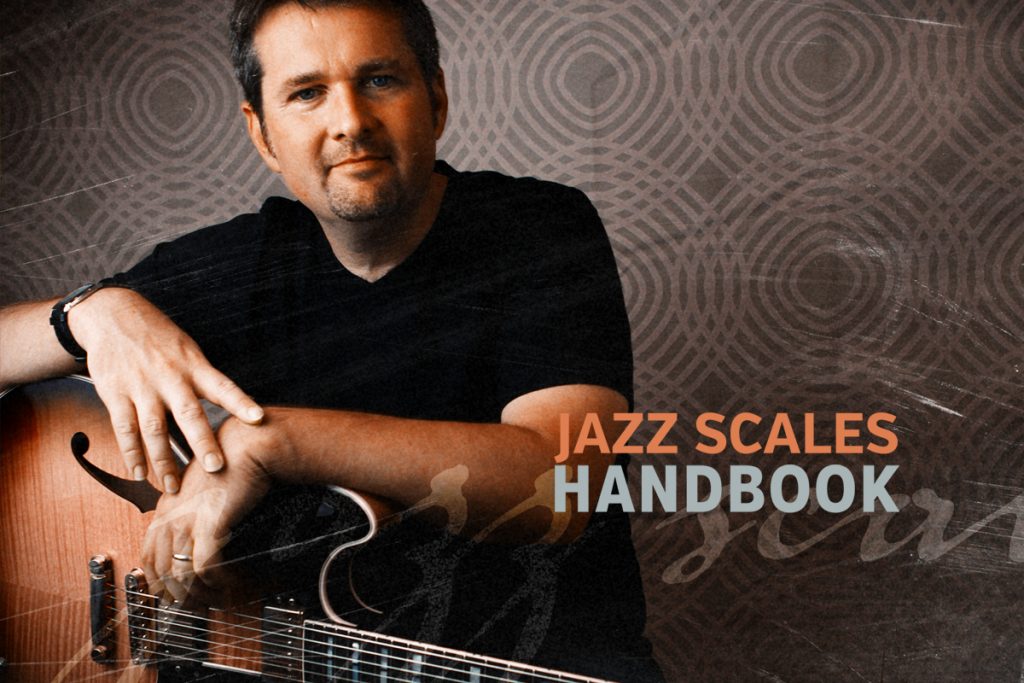These 7 free guitar lessons are from Tom Dempsey’s Jazz Scales Handbook, in this you’ll cover the most commonly used scales found in jazz and how these scales can apply any genre. So, if you’re a rock player, blues player or even a country player — learning these scales will help you become a better soloist. As you work through the Jazz Scales Handbook, you’re going to learn how to play these 20 scales, identify their distinctive sonic colors, and then apply them in a jazz setting.
Scales are the foundation of any musician’s improvisational vocabulary. Understanding how scales relate to specific chords and progressions broadens the player’s palette of possibilities when improvising.
Jazz Scales Handbook: Aeolian Scale
Download the tab & notation for this guitar lesson.
We’ve now arrived to our third and final minor mode, the Aeolian mode. This is also known as the Natural Minor scale. Because this mode is also consistent with the relative minor key of any major key, developing a strong understanding of this mode is paramount.
Here I’ll show you the mode in a two octave fingering in 5th position. We’ll see how it relates to the sound of its parent chord, the minor 7th chord, and we’ll also compare and contrast the nuances of this mode versus the previous two minor modes we’ve learned.
Jazz Scales Handbook: Aeolian Lick
Download the tab & notation for this guitar lesson.
The next musical idea we have here comes from the Aeolian mode. I’m presenting this over a very cool samba groove in A minor. Like the previous Lydian idea, here you’ll discover a lick that is both consistent with the sound of the Aeolian mode while incorporating a level of sophistication with the use of syncopation that is a huge component of the sound of this music. While getting the notes down is very important, it is at least equally important to develop a strong rhythmic concept. This lick will start to get you headed down that path.
Jazz Scales Handbook: Jazz Melodic Minor Scale
Download the tab & notation for this guitar lesson.
Here we’re going to look at the third type of minor scale, which is known as the Jazz Melodic Minor scale. In Western classical music, the Melodic Minor scale ascends one way using what we have here, but descends using the notes of the Natural Minor scale. In jazz, we ascend and descend the same way. This title is once again borrowed from George Russell’s text The Lydian Chromatic Concept. In this lesson, I’ll show you a two octave fingering of the scale along with its relationship to its parent chord, the minMaj7 chord. This scale has a lot of possibilities for use in improvisation and is an important one to add to your vocabulary.
Jazz Scales Handbook: Jazz Melodic Minor Lick
Download the tab & notation for this guitar lesson.
In this musical example, I’ll show you how you can use the Jazz Melodic Minor scale over a static C minor sound. The example I’m giving here is done much in the style of how Grant Green would use this sound. You can hear this type of idea all over Grant’s recordings. While we’re in a minor setting here, this same idea can also be applied to other chords to bring out related harmonies. It’s a very powerful sound that I’m sure you’ll dig.
Jazz Scales Handbook: Mixolydian b6 Scale
Download the tab & notation for this guitar lesson.
The Mixolydian b6 scale is the third dominant scale derived from the Jazz Melodic Minor scale. As the name implies, it has all the characteristics of a Mixolydian mode with an alteration on the sixth degree. This is a great sound to play over dominant 7th chords with a b13.
Here I’ll show you a two octave fingering of the scale in second position along with the arpeggio for the parent chord. Having scales in your repertoire that highlight specific extensions and alterations can be very helpful. And this scale answers a very specific and necessary need.
Jazz Scales Handbook: Mixolydian b6 Lick
Download the tab & notation for this guitar lesson.
Let’s look at a musical idea out of the sound of the Mixolydian b6 scale. Here I’ll show you a four bar lick from the G Mixolydian b6 scale that is played over a G7b13 chord with a swing groove. In playing this idea, you’ll notice that this scale really highlights that b13 tension on the dominant seventh chord. It’s like a little spice on your dominant chord. Sometimes just having that little bit of tension is just enough to add interest to you line.
Dig these Jazz Scales lessons? Download Tom Dempsey’s Jazz Scales Handbook for much more including tab, notation, and jam tracks!
